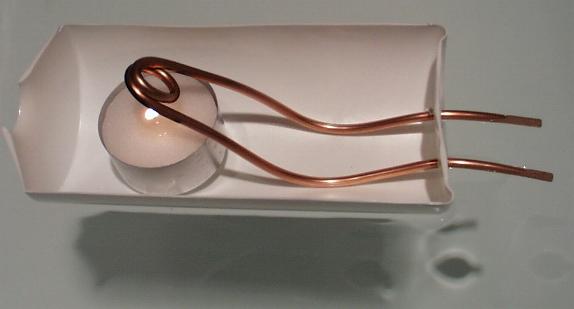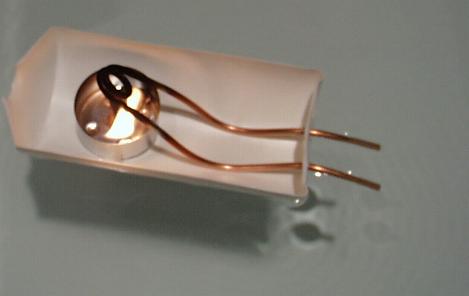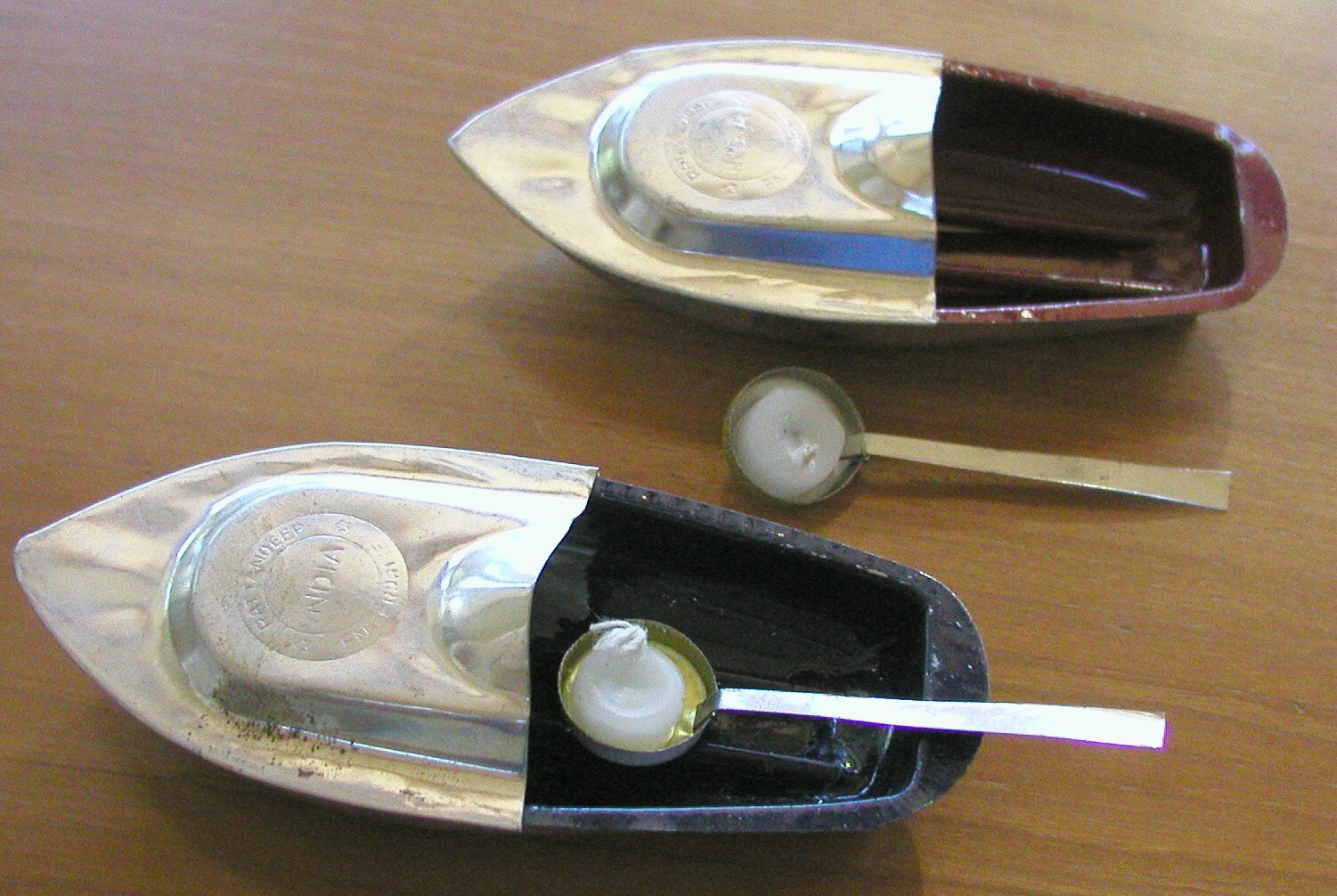This next toy is an example of the simplest steam engine you will ever see. It has no valves, no moving parts (in the traditional sense of the phrase), and yet it can propel it's little boat easily across the largest swimming pool or quiet duck pond.

The photograph above tells nearly all the construction details.
The boat is a plastic bottle, cut in half lengthwise. I used a soft plastic bottle that contact lens saline solution comes in. It is made of white High Density Polyethylene (HDPE), and is very easy to cut using an Xacto knife or other sharp utility knife.
Near the bow of the boat is a small candle, such as those used to keep food warm on the table. I chose a candle that comes with a small aluminum can, and is less than an inch high, so it would sit low in the boat and not drip wax all over. The aluminum cup keeps the melted wax in place, so the boat can go for hours. I used a small amount of sticky tape to keep it in place.
The engine is made of 1/8 inch soft copper tubing. This can be found at the better hardware stores, and is normally used in refrigerators. You can use the easier to find 1/4 inch soft copper tubing, but the 1/8 works best with the candle's small heat source, and weighs less, so it is less likely to tip the boat.
The best way to cut the tubing is with a tubing cutter (get it at the hardware store when you get the tubing). You can use a hacksaw, but you will have to clean the debris out of the cut with a knife or sandpaper.
Gently bend the tubing around a large pen or pencil (I used the handle of a wooden spoon) to form the coil in the center. Poke two holes in the back of the boat with a nail, and force the copper tubes through the holes. The holes in the soft plastic will close around the tubing, forming a water-tight fit. It is also possible to simply lay the tubing on the top of the back part of the boat, and then bend it down so the ends are under water, and pointing to the rear.
Gently bend the tubing so the coil is just above the top of where the candle flame will be. The boat is now finished, and ready to launch.
The copper tubes must be full of water, and both open ends must be under water. The easy way to fill the tubes is to hold one end under water, and suck on the other end.
When the tubes are full of water, and the boat is resting in the water with both ends of the tubing under the water, light the candle.
When the coil of copper tubing is hot enough to boil the water inside, the boat will jerk ahead suddenly, then start moving evenly forward. If you put your fingers in the water just behind the tubes, you can feel little pulses of water, about 5 or 10 pulses per second. These pulses are pushing the boat along.

In the photograph above, the candle has been replaced with a lump of charcoal starter cake. This makes a bigger flame, and makes the boat move even faster. The candle is safer, however.
In the photograph you may be able to just barely see the ripples in the water behind the boat. These ripples are caused by the 5 to 10 pulses per second that the engine makes as it operates. The easiest way to view this is to watch the reflection of a bright light on the surface of the water.
How does it do that?
When the water in the coil boils, the steam expands. This pushes the water out of the tubes. The reaction pushes the boat forward, as we explained earlier (and will explain in a different way when we look at rockets in a little bit).
As the steam continues to expand, it encounters the section of tubing that used to be full of water. This tubing is cold, and the steam condenses back into water. This causes a vacuum to form, which pulls more water back into the tubes.
You would expect that the water moving back into the tubing would cause the boat to go backwards. However, the water doesn't get very far before it hits the end of the tube (the two streams of water in the two tubes meet each other in the coil). Any motion caused by the water being sucked into the tubes is reversed by the water hitting the front of the tube (the coil) and pushing the boat forward again. As you saw when you put your finger near the tubes, this back and forth water motion is fairly rapid, and the comparatively heavy boat never actually moves backwards at all.
You can see a really nice little hand-made steamboat in our catalog, and shown below:

These are made in India on hand-operated presses, from tin plated steel. They are then hand-painted. They make a wonderfully loud "putt-putt-putt" sound as the steam around a bathtub, swimming pool, or pond.
They come with a tiny candle, and also a little wick so you can use olive oil as a fuel, which will run the engine for hours.